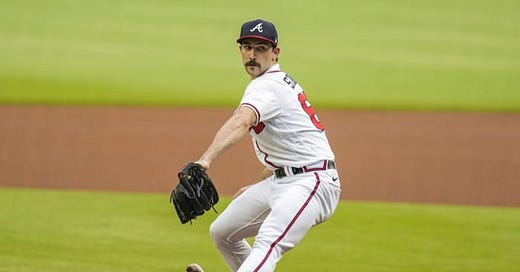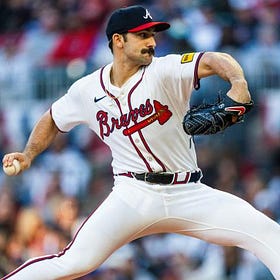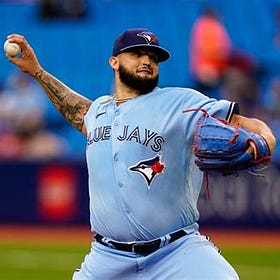The UCL Epidemic Part 3: The Case of Spencer Strider
Tradeoffs Exist Also at the Cellular Level

The Best Pitcher in Baseball
After supplanting himself as the best pitcher in baseball during the 2023 MLB season, Spencer Strider began the 2024 season as the Atlanta Braves opening day starter. During his second start of the season, Strider complained of elbow soreness and left the game. Subsequent MRI as well as orthopedic exam showed a tear in his already reconstructed right UCL. Strider underwent surgery to have his UCL reconstructed (again) later that week.
Does Strider follow the pattern of early physical outlier that ultimately breaks down later in the beginning of the prime of his career? Did he maximize his fitness landscape early on and ultimately become maladapted later?
Strider is an average sized 5”11” 195 lbs pitcher. Physically he is unimposing however he throws the ball at a well above average velocity for someone his size, with his fastball velocity in the upper 90’s. This led him to becoming the fastest pitcher to record 100 and subsequently 200 strikeouts in a season establishing new MLB records in the process. He was also a dominant power pitcher in college ringing up strikeouts at a very high rate while playing his college baseball at Clemson.
The Double-Edged Sword: Early Success & Tissue Specialization Leading to Long Term Genetic Tissue Senescence?
Searching the history of his career we can apply the Absolute theory. In high school Strider was a top prospect playing in many showcases namely Perfect Game. As is very common in North American youth sport, it seems that he specialized very early in the sport of baseball, most likely as a result of being physically better than the majority of his peers. As a pitcher, velocity is the metric upon which all are measured, so to gain the most competitive advantage as a pitcher, you must throw with very high velocities. Those that do attract major attention from NCAA and MLB scouts, even as early teenagers—if not earlier.
During his junior year of high school in 2016 Strider was throwing his fastball at 96 mph, slightly lower than his 2023 MLB average fastball velocity of 98 mph. Considering how often he would be playing and participating in elite tournaments and showcases during his high school years it would be safe to say at this time Strider had a great regenerative capacity as both chronological and biological age as well as early genetic fitness were on his side and provided him with a supreme advantage. As a young athlete he was maximizing these characteristics which lead him to be an outlier amongst his peers. This created a significant amount of MLB interest, as Strider was drafted in the 2017 MLB draft as a high schooler.
However, as we have discussed to this point (Part 1 and Part 2) the same genetics that allow for the maximization of fitness early on can become antagonistic later; what gives early, takes away later. This is manifest through an earlier shift in the beginning of body wide, but most specifically in this case soft tissue senescence. As a result of this it can become evident to witness a gradual system within a system degradation, in Strider’s case this began very early having his first catastrophic injury (UCL) in 2019 while at Clemson. Five years later, after regaining his physical metrics and becoming a dominant pitcher in MLB he is out again with another serious UCL injury.
The case of Spencer Strider as well as the many others in MLB and those in all other levels of professional baseball who suffer from UCL injuries begs the ultimate question:
Are we doing enough to mitigate the risk of serious arm (elbow) injuries in these highly specialized and highly dynamic athletes?
Maximizing Tissue Longevity: Mitigating the Effects of Senescence
The addition of tissue specific training could be one of the most valuable additions to any high performing athletes training regime as it mitigates against senescence. The ability of the white connective tissues to absorb, dissipate and transmit forces is a key component of any athletic movement and establishes the fundamentals of the behaviour of reactive strength.`
It is within the white tissues, inter-muscular, intra-muscular, tendons and ligaments where the effect of senescence (tissue aging) becomes the most prominent. It is during senescence, where the tissue degrades at a faster rate than can be regenerated over time. As a consequence the tissue loses its architectural framework, its elastic behaviours and its ability to manifest stiffness under load.
One of the fundamental behaviours of all tissues is their response to forces. The application of specific forces is the key stimulus that tissues use to organize themselves appropriately and then to display the necessary strength behaviours required to perform at a high level. It is the use of forces in training, performing both static and dynamic efforts that allows for the continued organization and remodelling of tissues that have been repeatedly stressed at high levels.
Force Based Inputs & Fibroblasts
Keep reading with a 7-day free trial
Subscribe to Absolute: The Art and Science of Human Performance to keep reading this post and get 7 days of free access to the full post archives.






